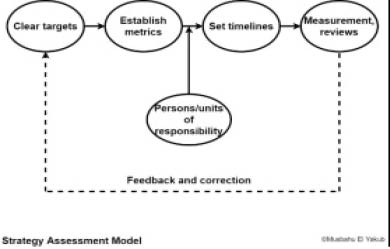Entrepreneurship Success – Business strategy (IV)
In the course of the Business Strategy series, we have so far defined what some terms that are often confused with strategy really mean as well as what strategy in business is. We have introduced the features of a great strategy, principles of strategy development, strategy frameworks and began discussions on strategy conceptualisation and development, […]

In the course of the Business Strategy series, we have so far defined what some terms that are often confused with strategy really mean as well as what strategy in business is. We have introduced the features of a great strategy, principles of strategy development, strategy frameworks and began discussions on strategy conceptualisation and development, which we will conclude today.
In what market will you operate? The value you will offer will in a way help define who your customers and potential market will be. But beyond the customers and markets, you will also need to be clear of who your existing competitors are in addition to the scope of likely competition.
It is amusing, if not unfortunate, how traditional car hire operators at our airports and hotels are largely heedless about competition from ride-hailing/e-hailing services such as Bolt and Uber. Both these operators, and a few local others, tend to offer lower drop and hourly rates than the conventional operators. However, the conventional operators are always quick to show or quote their ‘tariff’ as the basis for charging what they offer on a drop or hour-rate basis. This is unwise and can lead to business failures for unwillingness by the traditional operators to develop the right responsive strategies that should be both defensive and offensive.
Understanding your customers is about their demographics, their social standing in the society, their buying choices, habits, and capacities, as well as their overall size in numbers and market size. You will also need to understand the industry you are or will be operating within: What are the regulations governing operations in the industry? Who are your competitors and how do they do what they do? Key to success in understanding the customers, market, industry, and competition will be for you to be able to provide the value that is desired and cherished by your customers and for which they will gladly pay you at a profitable price and continue to buy from you and refer others to you rather than the competition.
What resources do you need? If you look around our environment, you cannot miss the many abandoned construction projects. Many of them are shops, malls and factories that have been left to literally rot away by their promoters. Other than the possibility that a project was probably abandoned because it was belatedly found not to be viable, most others are abandoned because the promoters could not raise the funds required to complete the projects. Now, think about the millions and perhaps, billions in Naira that have been tied-up, neither earning anything in the project nor invested elsewhere. The direct losses and opportunity cost over the years of the abandonment would amount to a few trillions across the country.
You can avoid the risks of tying up your investment without any returns by doing your homework diligently on two fronts: In the first instance by ensuring the viability of the business you are going into and second by planning to either immediately make the resources required available or, at the least, making fool-proof arrangements to have them available when you will need them. Resources will range from registrations and approvals, to cash, standby credit lines, equipment, raw materials, human capital, etc. Obviously, there is a timing element to when specific resources will be required. Regardless, you will need to secure firmed-up arrangements to have what you may need when you may need them.
What risks will you need to manage? We have in our ‘Risk Management’ series several weeks ago mentioned that contrary to what many people like to believe, business is not about some callous risk-taking. Rather, business is about understanding risks and what can be done about them. In understanding risks, there are three variables that are paramount; the likelihood of the occurrence of the risk, the likely negative impact if it does occur and what we can do about the risk(s). First, we are not interested in the risks that are satisfactorily unlikely to occur. As for those that may occur, we will begin to be interested in their likely negative consequences and what we can do about them.
Generally speaking, we have three options of treating risks that can crystalise: The risks that have minimal chances of occurrence and with minimum likely negative impact can either be eliminated or accepted depending on your risk profile. As for risks that can occur and do have highly likely negative impact, we will need to manage them through elimination, avoidance, reduction and/or transfer. The third group of risks are those that you can do very little about irrespective of the quantum of their likely negative impact. For these risks, you will need to make a call based on the facts and your personal and corporate risk propensity, taking into consideration the overall benefit that may, otherwise, be derivable.
Identifying risks and making sure that they are altogether eliminated where possible and/or managing those that cannot be eliminated entirely should be an integral part of your strategy conceptualisation, development, and planning.
How would you get things done? Quite honestly, many strategy books do not include ‘getting things done’ as part of the elements in conceptualising and developing business strategy. I think this is unwise for the simple reason that absolutely nothing good or desired happens without us doing something. In fact, if we do not do what we ought to, great chances are that it is bad and those things that we do not want may happen by ‘natural default’. Thus, planning how to get our strategy carried out should be an integral component of strategy development, and that is why we called it ‘strategic plan’ in our schematic last week.
How we get things done is about making sure that we have the competent people to do what needs to be done; make available other physical resources that may be required; continuously training our people to develop themselves to be able to do what needs to be done, etc.
Measurement: After the conceptualisation, development and carrying out of strategic plan, the entrepreneur and their team should regularly assess how well they are doing. This involves putting in place clear targets, establishing the appropriate metrics, deciding responsible persons/units, setting timelines, and conducting regular reviews to provide feedback by way of reinforcements and corrections.
The schematic below is a simple strategy assessment model.

Conceptualising, developing, executing, and regularly reviewing strategy that delivers value to your customers at a price that is acceptable to them and profitable to you is a core responsibility the entrepreneur should take seriously. Next week we will take up Decision-Making.
